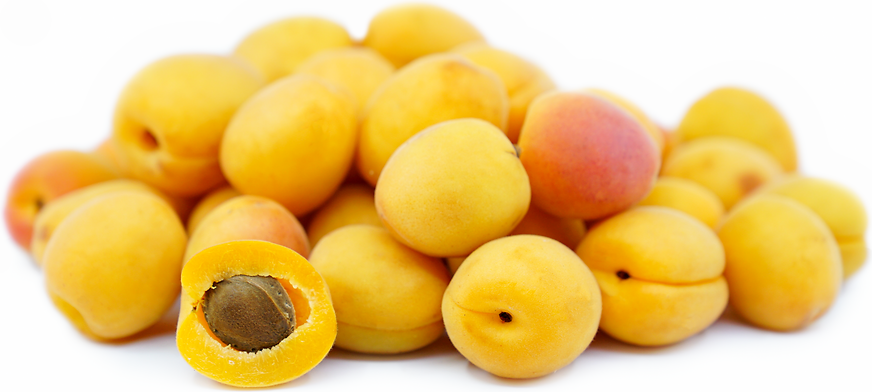


Aprium®
Estimated Inventory, lb : 0
Description/Taste
Aprium® fruits are small, round fruits with occasionally red-blushed, orange skin. They measure 5 to 6 centimeters in diameter and have characteristic apricot shape with a defined suture running from stem to tip. The smooth skin is covered in a light coat of fuzz and offers a firm texture. The bright orange flesh is juicy and doesn’t adhere to the central seed. Aprium® fruits are very sweet with little acid and a predominant apricot flavor with hints of raspberry and plum.
Seasons/Availability
Aprium® fruits are available in the late spring through summer.
Current Facts
Aprium® hybrid fruits are the result of a complex cross between plums and apricots. Botanically they are identified as Prunus armeniaca x Prunus salicina and are roughly 75% apricot and 25% plum. The process of creating an Aprium®, or what botanists call an “interspecific hybrid,” takes many years and requires a very controlled growing environment. Many different named Aprium® cultivars have been created since the early 1990s including Flavorella, Bella Sweet and Honey Gold, all developed to ripen at different times throughout the season.
Nutritional Value
Aprium® fruits are an excellent source of vitamins A and C and fiber. They are also a source of calcium, iron, and protein.
Applications
Aprium® fruits are ideal for eating raw, can be used in a variety of sweet applications, and can be utilized as a substitute in any recipe calling for apricots. They can be added to fresh fruit salads, green salads, or for an appetizer, the fruits can be halved and topped with soft cheeses or nuts. Aprium® fruits can also be cooked down or macerated for jams, sauces, frozen desserts, or beverages. Complimentary pairings include other stone fruits, honey, egg custards, lavender, citrus, strong spices, nuts, soft cheeses, and vanilla. Ripen Aprium® fruits at room temperature and then refrigerate for up to five days.
Ethnic/Cultural Info
Aprium® fruits are created by first cross pollinating a plum and an apricot. Apricot pollen is used on plum trees, resulting in plums with seeds that bear fruit that is a 50/50 cross. The seed is planted and becomes what growers call the “mother stock.” This ‘mother’ tree can produce both an Aprium® and a pluot®, which is genetically 75% plum and 25% apricot. If plum pollen is used for pollination, the resulting fruit will have predominantly plum characteristics and is considered a pluot®. If apricot pollen is used, the fruit will carry primarily apricot qualities and be considered an Aprium®.
Geography/History
Aprium® fruits were developed in the late 1980s, along with pluots®, by Floyd Zaiger of Zaiger Genetics, in Modesto, California. The fruit is the result of a long and multi-faceted process that takes several generations of crosses taking up to fifteen years. Once the initial process was developed, growers around the country began creating their own crosses. Several Central Valley, California orchards have created proprietary cultivars that are popular with home growers and offer a variety of harvest dates for commercial and small family growers. Aprium® fruits are predominately localized to farmers markets and specialty grocers in the United States.
Recipe Ideas
Recipes that include Aprium®. One
| Family tree farms |
|
Aprium Pistachio Oat Bars |
| Family tree farms |
|
Aprium Skillet Cake |
Podcasts




